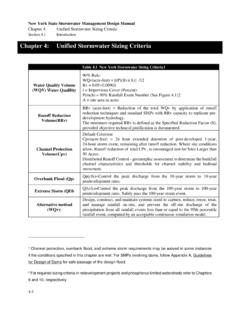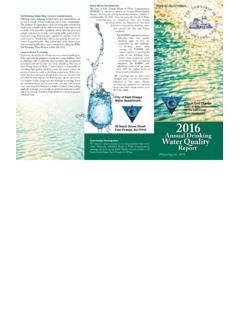Transcription of Training Module EPA530-K-05-010
1 Solid Waste and Emergency Response (5305W). Training Module EPA530-K-05-010 . Introduction to Containers (40 CFR Parts 264/265, Subpart I; ). United States Environmental Protection Agency September 2005. CONTAINERS. CONTENTS. 1. 1. 2. Regulatory Summary for Management of Containers .. 2. Applicability .. 2. Design 3. Operating Requirements .. 4. Inspections .. 5. 5. Special 6. 3. Regulatory Summary of the Requirements for Empty Containers .. 7. Regulatory 7. Special Issues: Aerosol 8. Containers - 1. 1. INTRODUCTION. Containers represent one of the most commonly used and diverse forms of units for hazardous waste storage. Compared to tanks or surface impoundments, containers are less expensive and generally less difficult to manage.
2 Containers are also mobile, allowing an owner or operator to use only one unit for storage, transportation, and disposal. Prior to regulation under the Resource Conservation and Recovery Act (RCRA), however, containers were frequently mismanaged or abandoned. When the abandoned containers became weathered or corroded, the hazardous contents were released, posing a far-reaching danger to human health and the environment. This Module reviews two sets of regulatory requirements for containers: requirements that pertain to the management of hazardous waste containers and regulations governing residues of hazardous waste in empty containers. The regulations covering management of hazardous waste stored in containers are found in 40 CFR Part 264/265, Subpart I.
3 These specific requirements must be met by the owners and operators of treatment, storage, and disposal facilities (TSDFs). and generators who accumulate hazardous waste in containers. The regulations regarding the management of empty containers and residues remaining in empty containers are found in These regulations set out procedures for establishing a container as "empty." Since empty containers no longer contain hazardous waste, these regulations are also used to determine when containers are no longer subject to the RCRA requirements. When you have completed this Module you will be able to apply the appropriate regulations governing hazardous waste containers and specifically will be able to: find the definitions of "container" and "empty container" and provide examples and citations for each provide an overview of the requirements for the design and operation of hazardous waste containers explain the difference between the container standards set out in Part 264 and Part 265.
4 State the requirements for rendering a hazardous waste container "RCRA empty". explain when container rinsate must be managed as a hazardous waste. Use this list of objectives to check your knowledge of this topic after you complete the Training session. The information in this document is not by any means a complete representation of EPA's regulations or policies, but is an introduction to the topic used for Training purposes. 2 - Containers 2. REGULATORY SUMMARY FOR MANAGEMENT OF CONTAINERS. Containers storing hazardous waste at permitted and interim status facilities are subject to the general facility standards in Part 264/265, Subparts A through E, as well as the unit-specific requirements in Part 264/265, Subpart I.
5 See the Training Module entitled RCRA Treatment, Storage, and Disposal Facilities for more information about the general facility standards. When EPA promulgated the unit-specific requirements for hazardous waste containers, the Agency emphasized that although mismanagement of containers has caused some of the worst contamination, relatively few regulations would be needed to eliminate most of these problems. These straightforward regulations are viewed simply as "good management practices." The regulations for containers in Part 264/265, Subpart I, include provisions regarding design and operating requirements, inspections, and closure. These requirements are designed to ensure that the integrity of the container is not breached; thus, the same standards apply regardless of whether the containers are used for treatment or storage.
6 Since the interim status standards in Part 265 are designed to regulate existing facilities until they can comply with the permitted standards, certain portions of the container regulations for interim status facilities are less stringent than those for permitted facilities. Specifically, the Part 265, Subpart I, regulations do not address requirements for secondary containment or closure, whereas the standards in Part 264, Subpart I do. Therefore, the discussions of these standards will only cite Part 264 standards. The following is a summary of the regulations affecting containers used to treat or store hazardous waste. APPLICABILITY. Unless a container is specifically exempted from regulation in 264/ , all containers storing hazardous waste must comply with the regulations found in Part 264/265, Subpart I.
7 Hazardous waste containers at generator sites must be in compliance with the Part 265 standards as well. A. container is any portable device in which a material is stored, transported, treated, disposed of, or otherwise handled ( ). This definition is intentionally broad to encompass all the different types of portable devices that may be used to handle hazardous waste. For example, a container may be a 55-gallon drum made from steel or plastic, a large tanker truck, a railroad car, a small bucket, or a test tube. Storage means holding hazardous waste for a temporary period, at the end of which the hazardous waste is treated, disposed of, or stored elsewhere. Again, this definition is made intentionally broad to include any situation in which hazardous waste is held for any period of time.
8 The information in this document is not by any means a complete representation of EPA's regulations or policies, but is an introduction to the topic used for Training purposes. Containers - 3. DESIGN REQUIREMENTS. The regulations governing the design of a container storage area are intended to ensure that the waste will not escape the storage area. These regulations ensure that the owner or operator is using a functional container and that the container will hold waste that is compatible with the container itself and other wastes in the container. In addition, the containers must be placed in a containment area designed to prevent releases from the containers from reaching the environment. The following sections detail these requirements.
9 CONDITION OF CONTAINER. Containers that are deteriorating ( , cracked, rusted) or leaking must not be used. Waste stored in defective containers must be transferred to containers in good condition or handled in another way that satisfies the requirements in Part 264/265 ( 264 ). COMPATIBILITY WITH WASTE. Sections 264 and 264 regulate situations involving incompatible wastes. The term incompatible waste refers to a hazardous waste which is unsuitable for (1) placement in a container because it may cause corrosion or decay of the container or inner liner; or (2). commingling with another waste or material under uncontrolled conditions because it might produce heat or pressure, fire or explosion, violent reaction, toxic dusts, mists, fumes or gases, or flammable fumes or gases ( ).
10 Containers used to store hazardous waste must be made of or lined with materials that will not react with and are otherwise compatible with the waste in the container ( 264 ). Incompatible wastes and materials must not be placed in the same container ( 264 ). This requirement includes unwashed containers that previously held an incompatible waste or material. Incompatible wastes or materials can only be mixed in a manner that will not cause an adverse reaction, such as an explosion or uncontrolled flammable fumes ( 264 (b)). Appendix V in Part 264/265 provides a list of potentially incompatible wastes. The list is not intended to be exhaustive. Adequate analysis should be performed to avoid creating uncontrolled hazards such as heat generation, violent reaction, fire, explosion, and generation of flammable or toxic gases.











